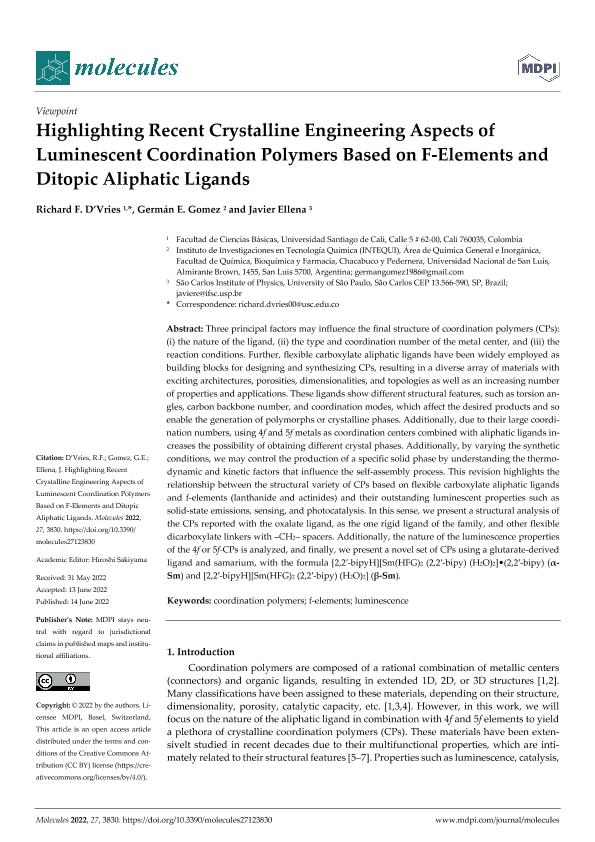Mostrar el registro sencillo del ítem
dc.contributor.author
D'Vries, Richard F.
dc.contributor.author
Gomez, Germán Ernesto

dc.contributor.author
Ellena, Javier Alcides

dc.date.available
2023-09-13T11:32:02Z
dc.date.issued
2022-06
dc.identifier.citation
D'Vries, Richard F.; Gomez, Germán Ernesto; Ellena, Javier Alcides; Highlighting Recent Crystalline Engineering Aspects of Luminescent Coordination Polymers Based on F-Elements and Ditopic Aliphatic Ligands; Molecular Diversity Preservation International; Molecules; 27; 12; 6-2022; 3830-3845
dc.identifier.issn
1420-3049
dc.identifier.uri
http://hdl.handle.net/11336/211326
dc.description.abstract
Three principal factors may influence the final structure of coordination polymers (CPs): (i) the nature of the ligand, (ii) the type and coordination number of the metal center, and (iii) the reaction conditions. Further, flexible carboxylate aliphatic ligands have been widely employed as building blocks for designing and synthesizing CPs, resulting in a diverse array of materials with exciting architectures, porosities, dimensionalities, and topologies as well as an increasing number of properties and applications. These ligands show different structural features, such as torsion an-gles, carbon backbone number, and coordination modes, which affect the desired products and so enable the generation of polymorphs or crystalline phases. Additionally, due to their large coordination numbers, using 4f and 5f metals as coordination centers combined with aliphatic ligands increases the possibility of obtaining different crystal phases. Additionally, by varying the synthetic conditions, we may control the production of a specific solid phase by understanding the thermo-dynamic and kinetic factors that influence the self-assembly process. This revision highlights the relationship between the structural variety of CPs based on flexible carboxylate aliphatic ligands and f-elements (lanthanide and actinides) and their outstanding luminescent properties such as solid-state emissions, sensing, and photocatalysis. In this sense, we present a structural analysis of the CPs reported with the oxalate ligand, as the one rigid ligand of the family, and other flexible dicarboxylate linkers with –CH2– spacers. Additionally, the nature of the luminescence properties of the 4f or 5f-CPs is analyzed, and finally, we present a novel set of CPs using a glutarate-derived ligand and samarium, with the formula [2,2′-bipyH][Sm(HFG)2 (2,2′-bipy) (H2O)2]•(2,2′-bipy) (α-Sm) and [2,2′-bipyH][Sm(HFG)2 (2,2′-bipy) (H2O)2] (β-Sm).
dc.format
application/pdf
dc.language.iso
eng
dc.publisher
Molecular Diversity Preservation International

dc.rights
info:eu-repo/semantics/openAccess
dc.rights.uri
https://creativecommons.org/licenses/by-nc-sa/2.5/ar/
dc.subject
DITOPIC LIGANDS
dc.subject
F-ELEMENTS
dc.subject
LUMINISCENCE
dc.subject
CRYSTALLINE ENGINEERING
dc.subject.classification
Química Inorgánica y Nuclear

dc.subject.classification
Ciencias Químicas

dc.subject.classification
CIENCIAS NATURALES Y EXACTAS

dc.title
Highlighting Recent Crystalline Engineering Aspects of Luminescent Coordination Polymers Based on F-Elements and Ditopic Aliphatic Ligands
dc.type
info:eu-repo/semantics/article
dc.type
info:ar-repo/semantics/artículo
dc.type
info:eu-repo/semantics/publishedVersion
dc.date.updated
2023-07-06T11:11:37Z
dc.journal.volume
27
dc.journal.number
12
dc.journal.pagination
3830-3845
dc.journal.pais
Suiza

dc.journal.ciudad
Basel
dc.description.fil
Fil: D'Vries, Richard F.. Universidad Santiago de Cali; Colombia
dc.description.fil
Fil: Gomez, Germán Ernesto. Consejo Nacional de Investigaciones Científicas y Técnicas. Centro Científico Tecnológico Conicet - San Luis. Instituto de Investigaciones en Tecnología Química. Universidad Nacional de San Luis. Facultad de Química, Bioquímica y Farmacia. Instituto de Investigaciones en Tecnología Química; Argentina
dc.description.fil
Fil: Ellena, Javier Alcides. Universidade de Sao Paulo; Brasil
dc.journal.title
Molecules

dc.relation.alternativeid
info:eu-repo/semantics/altIdentifier/url/https://www.mdpi.com/1420-3049/27/12/3830
dc.relation.alternativeid
info:eu-repo/semantics/altIdentifier/doi/http://dx.doi.org/10.3390/molecules27123830
Archivos asociados
